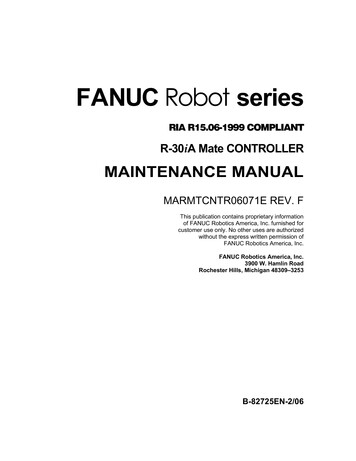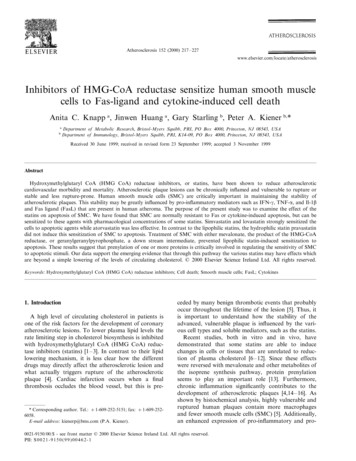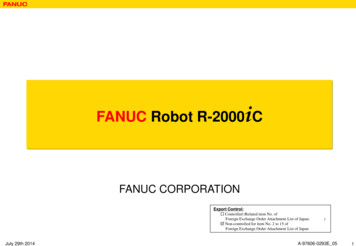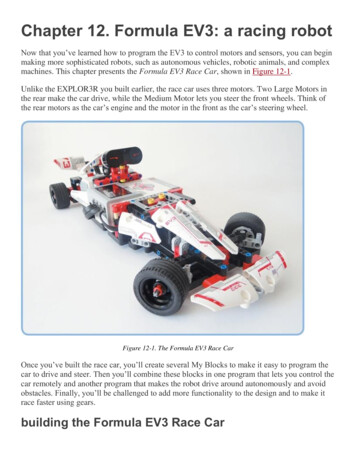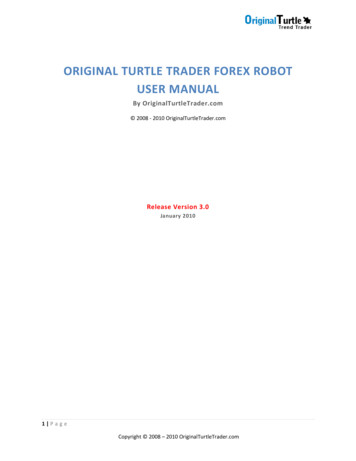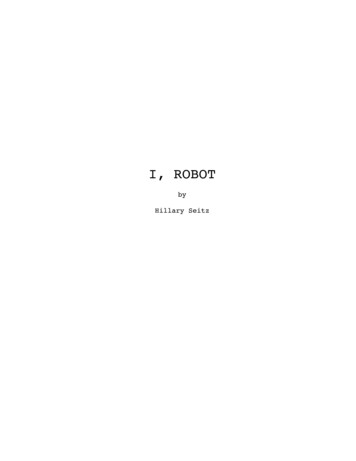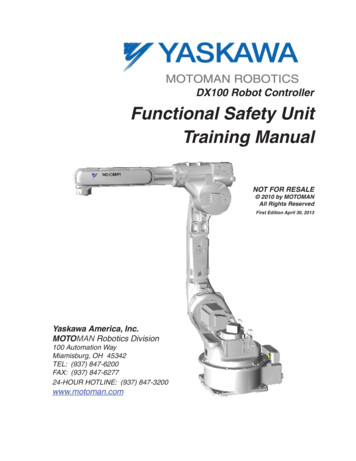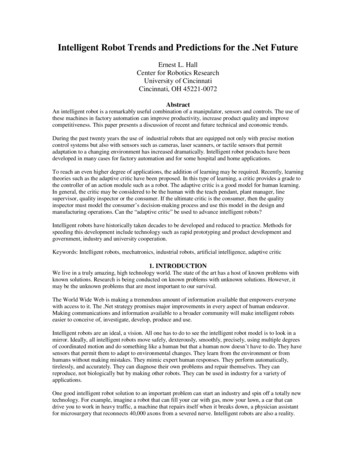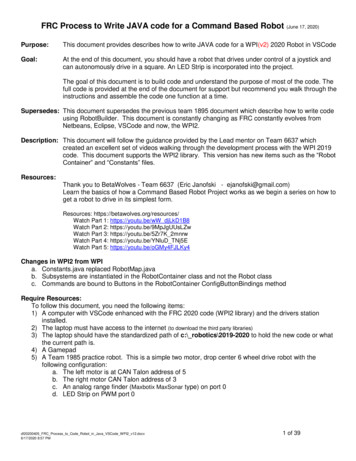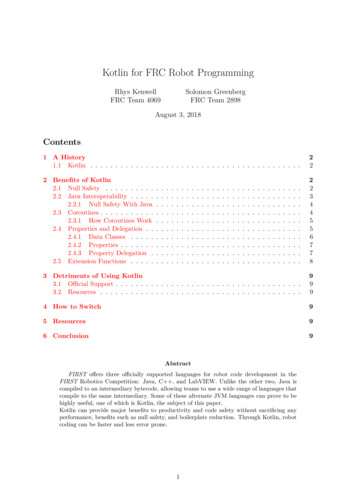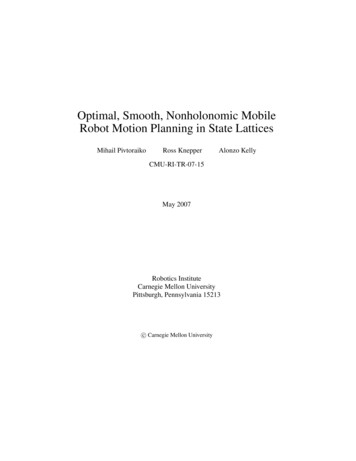
Transcription
Optimal, Smooth, Nonholonomic MobileRobot Motion Planning in State LatticesMihail PivtoraikoRoss KnepperAlonzo KellyCMU-RI-TR-07-15May 2007Robotics InstituteCarnegie Mellon UniversityPittsburgh, Pennsylvania 15213c Carnegie Mellon University
AbstractWe present an approach to the problem of mobile robot motion planning in arbitrarycost fields subject to differential constraints. Given a model of vehicle maneuverability, a trajectory generator solves the two point boundary value problem of connectingtwo points in state space with a feasible motion. We use this capacity to compute acontrol set which connects any state to its reachable neighbors in a limited neighborhood. Equivalence classes of paths are used to implement a path sampling policy whichpreserves expressiveness while eliminating redundancy. The implicit repetition of theresulting minimal control set throughout state space produces a reachability graph thatencodes all feasible motions consistent with this sampling policy. The graph encodesonly feasible motions by construction and, by appropriate choice of state space dimension, can permit full configuration space collision detection while imposing headingand curvature continuity constraints at nodes. Nonholonomic constraints are satisfiedby construction in the trajectory generator. We also use the trajectory generator to compute an ideal admissible heuristic and significantly improve planning efficiency. Comparisons to classical grid search and nonholonomic motion planners show the plannerprovides better plans or provides them faster or both. Applications to planetary roversand terrestrial unmanned ground vehicles are illustrated.I
Contents1.112445Search Space Design2.1 Conversion to a Sequential Decision Process . . . . . . . .2.2 Configuration and State Spaces . . . . . . . . . . . . . . .2.3 Sampled Representations and Spatial Equivalence Classes2.4 Regular Lattices and Grids . . . . . . . . . . . . . . . . .2.5 Feasible Lattices . . . . . . . . . . . . . . . . . . . . . .5566783The State Lattice3.1 Modeling Vehicle Maneuverability . . . . . . . . . . . . . . . . . . .3.2 Desiderata and Design Approach . . . . . . . . . . . . . . . . . . . .3.3 Sampling the Heading Dimension . . . . . . . . . . . . . . . . . . .8910104Primitive Control Sets4.1 Extended Neighborhoods . . . . . . . . . . . . . . . .4.2 Redundant Controls and Path Decomposition . . . . .4.3 Generating Primitive Control Sets with Path Sampling4.4 Automatic Generation of the Control Set . . . . . . . .1111121214Motion Planning using Control Sets5.1 Search Algorithm . . . . . . . . . . . . . . . . .5.2 Qualities of Motion Planning in State Lattices . .5.3 Implementation Considerations . . . . . . . . . .5.4 Heuristic Cost Estimate . . . . . . . . . . . . . .5.5 Heuristic Look-Up Table . . . . . . . . . . . . .5.5.1 Constructing the Heuristic Look-Up Table5.5.2 Populating the Heuristic Look-Up Table .1616171819202021Results6.1 Experimental Setup . . . . . . . . . . . . . . . . . . . . . . . . .6.2 Comparison of the Lattice to Other Control Sets . . . . . . . . . .6.2.1 Comparison to a Grid Planner . . . . . . . . . . . . . . .6.2.2 Comparison to Full C Space and Nonholonomic Planners6.3 Heuristics . . . . . . . . . . . . . . . . . . . . . . . . . . . . . .242526273032Applications7.1 Off-road Navigation . . . . . . . . . . . . . . . . . . . . . . . . . . .7.2 Planetary Rover Locomotion . . . . . . . . . . . . . . . . . . . . . .7.3 Reactive Motion Planning and Path Modification . . . . . . . . . . .343435382567Introduction1.1 Motivation . . . . .1.2 Related Work . . .1.3 Problem Statement1.4 Approach . . . . .1.5 Outline . . . . . .III.
8Summary389Conclusion and Future Work39IV
1IntroductionDiscrete representation of states is a well-established method of reducing the computational complexity of planning at the expense of reducing completeness. However, inmotion planning, such discrete representations complicate the satisfaction of differential constraints which reflect the limited maneuverability of many real vehicles. Wepropose a mechanism to achieve the computational advantages of discretization whilesatisfying motion constraints.To this end we introduce a search space, referred to as the state lattice. The latticeis used to formulate a nonholonomic motion planning query as graph search. The statelattice encodes a graph whose nodes are a discretized set of all reachable configurationsof the system and whose edges are feasible motions which connect these states exactly.The process of forming edges does not make the standard assumption that adjacentnodes are necessarily connected. Rather, every node is connected by an edge to onlythose nodes in a small neighborhood for which a feasible connecting motion exists.Conversely, it is typical to assume that adjacent cells in a 2D grid are connected ina 4-connected or 8-connected arrangement. Such default connectivity fails to capturenonholonomic and continuity constraints. For example, a 90 degree turn at finite speedassumes either that wheels can move sideways or steering angles can change infinitelyfast or both. In such search spaces, differential constraints must be considered heuristically in the optimization process during planning, or as an afterthought in plan postprocessing. The state lattice, however, has an important property that each connectionrepresents a feasible primitive motion. Such a graph topology - one that intrinsicallymeets mobility constraints - leads to superior motion planning results because no timeis wasted generating, evaluating, or fixing infeasible plans.It is convenient to sample state space in a regular fashion so that the motions encoded in the edges of the state lattice form a repeating unit that can be copied to everynode while preserving the property that each edge will continue to join neighboringnodes exactly. This canonical set of repeating edges is called the control set. The number of edges in the control set is exactly the outdegree of each node in the reachabilitygraph, so it is important to minimize it for efficiency. We will propose path samplingmethods which automatically produce a minimal set of primitive paths that, when concatenated, can reproduce any feasible path in the continuum of state space up to someresolution.1.1MotivationThis work is motivated by a number of applications which have not been served aswell by the planners of the day as they would have been by the planner proposed here.In the context of unmanned ground vehicles, competence in motion planning in denseobstacle fields demands the use of sufficiently high fidelity models of constrained motion, at least in the near field. Our repeated attempts to get by with less have not beenparticularly successful. A classic case is that of an Ackerman vehicle which drives intoa winding corridor only to find it is closed off. Then, the robot must turn around usingmany reversals of velocity while avoiding the obstacles surrounding it.Another case of contemporary interest is that of a planetary rover which must visit1
a large number of nearby locations when, for every motion, only one of the rocks inview is (roughly) the goal and everything else is an obstacle. Furthermore, the goal isthe correct vehicle state for deploying a microscopic imager to a 1 cm by 1cm patchof a particular boulder. Hence the planner must not only target a particular heading,but its ability to do so also depends on eliminating the errors that will be induced bydiscontinuous curvatures embedded in the path to get there.A great deal of the motion planning literature still concentrates on the theoreticalaspects of the problem. Our approach in this paper departs somewhat from this legacybecause we are charged to do our best in the field robotics applications of today. Theapproach presented here has been conceived through work with off-road mobile vehicles, and its development has been entirely driven by the humbling business of fieldwork. The question of efficiency has received considerable attention. We thereforecontribute to the growing trend of describing the efficiency of our results in great detailand we offer comparisons of our method to other popular approaches.1.2Related WorkA significant amount of work has been dedicated in recent years to the problem ofsmooth inverse trajectory generation for nonholonomic vehicles: finding a smooth andfeasible path given two end-point configurations. While in general this is a difficultproblem, recent progress in this area produced a variety of fast algorithms. The groundbreaking work in analyzing the paths for nonholonomic vehicles was done by Dubins[19] and Reeds and Shepp [49]. Their ideas were further developed in algorithmsproposed by Scheuer and Laugier [54], Fraichard and Ahuactzin [21], and Fraichardand Scheuer [22] where smoothness of paths was achieved by introducing segments ofclothoids (curves whose curvature is a linear function of their length) along with arcsand straight line segments. Somewhat different approaches by Scheuer and Fraichard[53], and Lamiraux and Laumond [36], among others, have also been shown to solvethe generation problem successfully and quite efficiently. On the other hand, Frazzoli,Dahleh and Feron [23] suggest that there are many cases where efficient, obstaclefree paths may be computed analytically, e.g. the systems with linear dynamics anda quadratic cost (double or triple integrators with control amplitude and rate limits).The cases that do not admit closed-form solutions can be approached numerically bysolving appropriate optimal control problems (e.g. [20], [4]). A fast nonholonomictrajectory generator by Kelly and Nagy [32], Howard and Kelly [26] generates polynomial spiral trajectories using parametric optimal control. The latest results of this workappear in another article in this issue.Some of the methods described above also proposed applications to planning amongobstacles. Since the beginning of modern motion planning research ([45], [44], [50]),there has been interest in the planning methods that constructed boundary representations of configuration space obstacles ([15], [2], [1] and others). The complexityof motion planning algorithms has also been studied ([16], [47], [3], [28]). With theadvent of efficient C-space sampling methods ([6], [25]), there has been interest inalgorithms that sample the space in deterministic fashion ([7], [9], others in [37]). Lacaze et al. [35] utilized these ideas to propose a method for planning over rough terrainusing generation of motion primitives by integrating the forward model. Cherif [18]2
advanced these concepts by basing planning on physical modeling. Note that one ofprincipal differences (and a novelty, to our knowledge) of our approach is leveragingthe research in inverse trajectory generators to generate motion primitives under convenient discretization.Also in the early 1990’s, randomized sampling was introduced to motion planning([8], among others). The Probabilistic Roadmap (PRM) methods were shown to bewell-suited for path planning in C-spaces with many degrees of freedom ([29], [30],[27]), and with complex constraints, e.g. nonholonomic, kinodynamic, etc. ([34], [27],[17], [33]). Another type of probabilistic planning was Rapidly-exploring RandomTrees (RRT) introduced by LaValle and Kuffner ([39],[40]). RRT’s were originallydeveloped for handling differential constraints, although they have also been widelyapplied to the Piano Mover’s problem ([38]). Randomized approaches are understoodto be incomplete, strictly speaking, but capable of solving many challenging problemsquite efficiently ([14]).As the randomized planners became increasingly well understood in recent years,it was suggested that their efficiency was not due to randomization itself. LaValle,Branicky and Lindemann [41] suggest an intuition that real random number generatorsalways have a degree of determinism. In fact, Branicky et al. [14] show that quasirandom sampling sequences can accomplish similar or better performance than theirrandom counterparts. The improvements in performance are primarily attributed to themore uniform sampling of quasi-random methods, and hence LaValle, Branicky andLindemann [41] suggest that a carefully designed low-discrepancy incremental deterministic sequence would be able to do just as well ([42], [43]). For these reasons,Branicky et al. [14] introduced Quasi-PRM and Lattice Roadmap (LRM) algorithmsthat used low-discrepancy Halton/Hammersley sequences and a regular lattice, respectively, for sampling. Both methods were shown to be resolution-complete, while theLRM appeared especially attractive due to its properties of optimal dispersion and nearoptimal discrepancy. In this light, our approach of sampling on a regular lattice can beconsidered to be one of building on the LRM idea and making it more efficient througha detailed analysis of a fit between the reachability graph of the system and the underlying sampling lattice.Recent works have also discussed ”lazy” variants of the above planning methodsthat avoid collision checking during the roadmap construction phase (e.g. [13], [12],[14], [51], [52]). In this manner the same roadmap could be used in a variety of settings,at the cost of performing collision checking during the search. An even ”lazier” versionis suggested, in which ”the initial graph is not even explicitly represented” [14]. In thisregard, our approach of using an implicit lattice and searching it by means of a precomputed control set that only captures local connectivity is similar to the Lazy LRM.Our contribution is in exploring the conjecture made in that work and successfullyapplying it to nonholonomic motion planning.The question of lattice sampling has also been raised in the context of motion planning utilizing control quantization. Bicchi, Marigo and Piccoli [11] as well as Pancanti,Pallottino and Bicchi [48] showed that, for systems that can be expressed as that are notunderactuated, through careful discretization in control space, it is possible to force theresulting reachability graph of system to be a lattice. It was also shown that this technique can be applied to a large class of nonholonomic systems. That approach presents3
a way to generate a path given its terminal points and shows how under suitable conditions a regular lattice of reachable points can be achieved. However, this is usuallydifficult to achieve, and under most quantizations the vertices of the reachability graphare unfortunately dense in the reachable set [38]. By contrast, our method uses an inverse path generator capable of generating essentially any feasible motion, so we canchoose a convenient discretization of state space based on the problem demands andgenerate a custom set of controls to suit this discretization.In this work we also build on a considerable amount of research in analysis of system reachability. One line of research uses planning methods themselves to analyzereachability of complex systems [10]. Since we focus on applications of motion planning of wheeled vehicles, we have developed a technique based on exhaustive searchthat has worked quite well for exploration of the reachability graph. Our method involves pruning this search early to analyze reachability efficiently.In the development of Rapidly-exploring Dense Trees [38] for motion planningwith differential constraints, the importance of designing off-line a family of motionprimitives that captures the specifics of the system under consideration is noted [38]. Inthis light, our proposed control set is precisely that set of primitives that reflects symmetries of wheeled vehicles and encodes nonholonomic constraints via off-line reachability analysis. Thus, this work is aligned with the latest developments of differentiallyconstrained motion planning research, while continuing the latest trends of deterministic sampling methods and the efficiencies of ”lazy” exploration of state space.Initial concepts of this work were validated in a successful field implementation of anonholonomic motion planner built using an earlier version of the state lattice of limitedsize represented explicitly [31]. In this article, we propose significant improvementsin efficiency and generality while recasting the approach to generate the reachabilitygraph on-line as it is searched.1.3Problem StatementThe basic problem we address here is that of finding a feasible path between two givenpostures in the presence of arbitrary obstacles. If no path exists between the postures,the solution should indicate that, and otherwise it must find a solution. This rule isenforced as the sampling resolution approaches zero. The previous statement impliesthat the objective is a resolution-complete path planner. We also desire the solution tobe optimal with respect to an arbitrary but well behaved notion of a path’s cost (wherecost could be assigned to path length).1.4ApproachThe approach presented in this work builds upon a long heritage and many strengthsof earlier motion planning techniques in order to achieve a solution of a highly generalform and real-time performance.Our aim is to leverage the previous effort, and combine these leading ideas in anovel and unique manner. In particular, our method builds upon the previous introduction of an implicit representation of the search space [14], latest research in inverse4
trajectory generation ([54], [23], [26] among others), incremental deterministic sampling ([41]), and an off-line analysis of the reachability set of the system for greatlyimproved on-line performance.In general terms, the crux of our proposal is the generation of a search space (agraph) that satisfies differential constraints by construction. The problem of motionplanning is thereby reduced to unconstrained heuristic search and any generated planmust be feasible. We show that a planner can be built using this search space with nodeoutdegree comparable to that of a grid. Hence, similar efficiencies are obtained in thegeneration of plans of equal numbers of states. Moreover, through a careful design ofa search heuristic, we can preserve this efficiency even with a node outdegree that isconsiderably higher.1.5OutlineThe paper is organized into 9 sections. In Section 2 we embark from our problemdefinition and carefully construct the design of a special search space that our techniqueis based upon; we discuss its features and requirements. We develop these designdecisions in Section 3 into a concrete specification of a search space that satisfies theserequirements, a state lattice. In the following Section 4, an implicit representation of thestate lattice as a theoretical construct is derived with the goal of practical and efficientmotion planning. Section 5 is dedicated to the details of exploiting the properties of thisspace for building an efficient heuristic search algorithm. In Section 6 we analyze theperformance of the presented motion planner using some standard benchmarks and alsoin comparison to basic grid search. Section 7 is dedicated to a discussion of concreterobotics applications where this work can be quite beneficial. Section 8 summarizesthe paper. We conclude in Section 9 with closing remarks, and future plans for thisresearch.2Search Space DesignThis section presents a progression of design principles that, when followed, result inthe creation of a search space which is well-suited to motion planning problems subjectto differential constraints. The search space that results satisfies such constraints byconstruction, enabling path planning to proceed without considering them at all. Theresulting solution path is therefore
The cases that do not admit closed-form solutions can be approached numerically by solving appropriate optimal control problems (e.g. [20], [4]). A fast nonholonomic trajectory generator by Kelly and Nagy [32], Howard and Kelly [26] generates polyno-mial spiral trajectories using parametric
